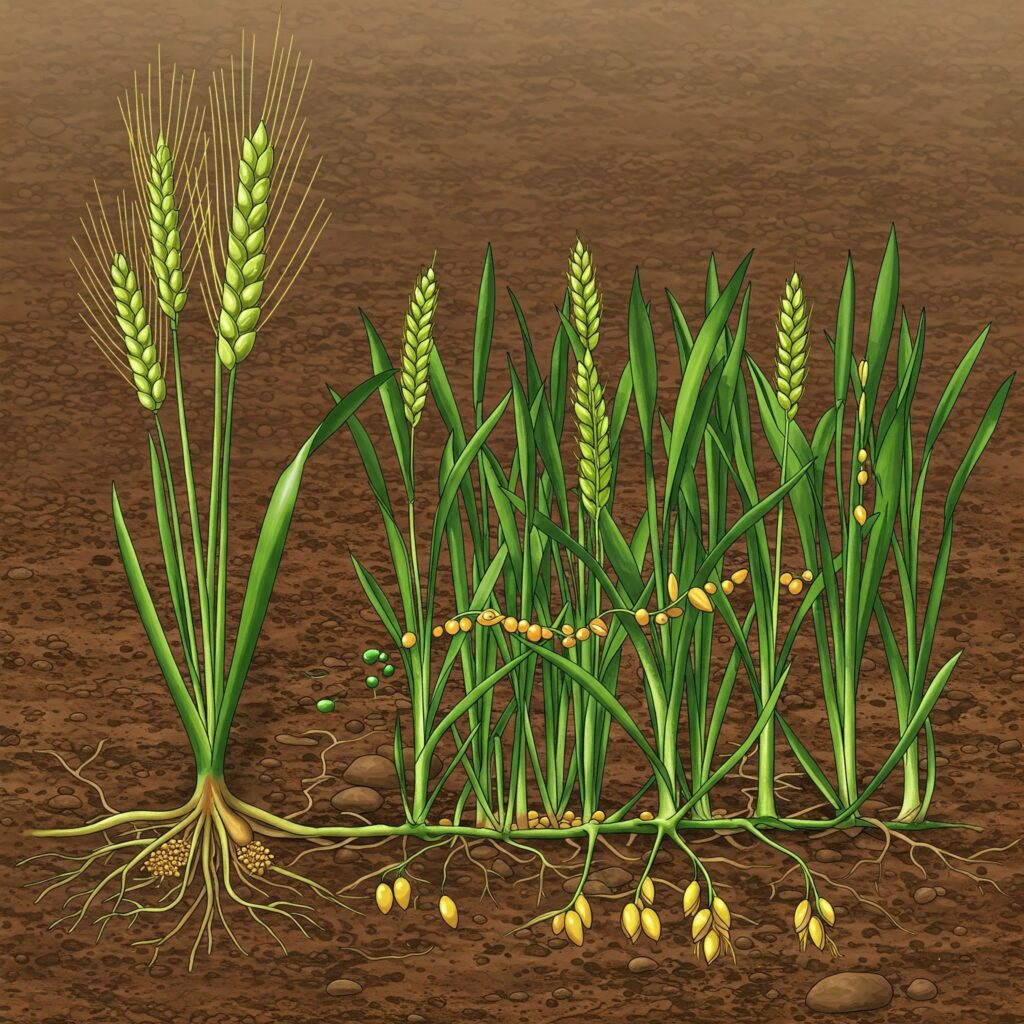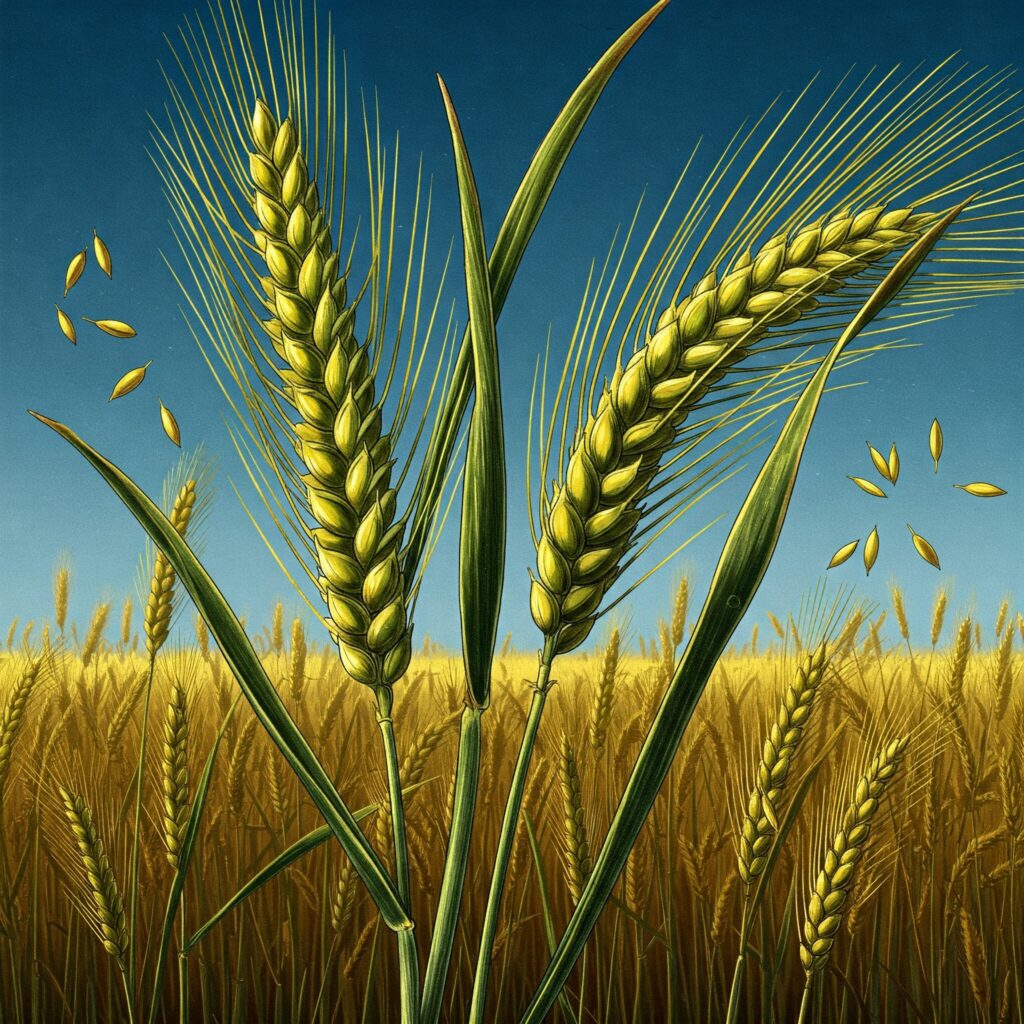Wheat, a fundamental cereal worldwide, has a life cycle with well-defined phenological stages. Understanding these phases is essential for implementing efficient agronomic management and maximizing your crop yield. Below, we will explore each stage of wheat development, providing valuable information for students and professionals in agronomy.
Key Stages in Wheat Development
Germination and Emergence: The Beginning of the Cycle
Germination marks the beginning of the wheat’s life, from sowing until the seedling appears above the soil surface. This critical process is directly influenced by soil temperature and moisture.

Vegetative Development: Establishing the Foundation for Yield
After emergence, the wheat plant enters the vegetative development phase. During this period, leaves, stems, and the root system are formed, establishing a solid structure for future growth.

Tillering: Multiplying Productive Potential
Tillering is a crucial process in which the plant develops additional stems from the base. Each of these stems has the capacity to produce a spike, which directly impacts the potential yield of the crop.

Heading and Flowering: The Reproductive Phase
In this stage, the wheat spike emerges from the stem, and flowering begins. Pollination in wheat is generally self-pollination, occurring within the spike. Environmental conditions play an important role in this process.
Grain Filling and Maturity: The Development of Final Yield
After flowering, grain filling begins, where the wheat kernels develop and mature. This phase is decisive for the quality and quantity of the final crop yield.

Harvest: The Time of Collection
Harvest takes place when the grain has reached its full maturity and the moisture content is suitable for storage. Determining the optimal harvest time is crucial to ensure the maximum quality and yield of the harvested wheat.
Nutrient recommendations for wheat cultivation
| Stage/Sub-stage | Nutrients | Recommended dose |
| Soil preparation and sowing | Nitrogen (N), Phosphorus (P), Potassium (K) | N: 60-120 kg/ha, P: 40-80 kg/ha, K: 60-100 kg/ha |
| Calcium (Ca), Magnesium (Mg) | Ca: 20-40 kg/ha, Mg: 10-30 kg/ha | |
| Micronutrients (Fe, Mn, Zn) | According to soil analysis | |
| Germination and emergence | Nitrogen (N), Phosphorus (P), Potassium (K) | N: 20-40 kg/ha, P: 20-40 kg/ha, K: 20-40 kg/ha |
| Calcium (Ca), Magnesium (Mg) | Ca: 10-20 kg/ha, Mg: 5-10 kg/ha | |
| Micronutrients | According to soil or foliar analysis | |
| Vegetative development | Nitrogen (N), Potassium (K) | N: 60-100 kg/ha (split application), K: 60-100 kg/ha (split application) |
| Phosphorus (P) | P: 40-80 kg/ha (split application) | |
| Calcium (Ca), Magnesium (Mg) | Ca: 20-40 kg/ha, Mg: 10-30 kg/ha | |
| Micronutrients | According to soil or foliar analysis | |
| Tillering | Nitrogen (N), Potassium (K) | N: 80-120 kg/ha, K: 80-120 kg/ha |
| Phosphorus (P) | P: 40-80 kg/ha | |
| Calcium (Ca), Magnesium (Mg) | Ca: 20-40 kg/ha, Mg: 10-30 kg/ha | |
| Micronutrients | According to soil or foliar analysis | |
| Heading and booting | Nitrogen (N), Potassium (K) | N: 100-150 kg/ha, K: 100-150 kg/ha |
| Phosphorus (P) | P: 60-100 kg/ha | |
| Calcium (Ca), Magnesium (Mg) | Ca: 30-50 kg/ha, Mg: 20-40 kg/ha | |
| Micronutrients | According to soil or foliar analysis | |
| Grain formation and filling | Nitrogen (N), Potassium (K) | N: 100-150 kg/ha, K: 100-150 kg/ha |
| Phosphorus (P) | P: 60-100 kg/ha | |
| Calcium (Ca), Magnesium (Mg) | Ca: 30-50 kg/ha, Mg: 20-40 kg/ha | |
| Micronutrients | According to soil or foliar analysis | |
| Maturation and harvest | Nitrogen (N), Potassium (K) | N: 60-100 kg/ha, K: 60-100 kg/ha |
| Phosphorus (P) | P: 40-80 kg/ha | |
| Calcium (Ca), Magnesium (Mg) | Ca: 20-40 kg/ha, Mg: 10-30 kg/ha | |
| Micronutrients | According to soil or foliar analysis |
Note: These recommendations are general and should be adjusted according to the specific conditions of your soil, climate, wheat variety, and agronomic practices. Conducting periodic soil and foliar analyses is crucial to determine the precise nutrient doses. Always follow local regulations and the guidance of agricultural professionals.
Conclusion
A thorough understanding of the phenological stages of wheat is fundamental for successful agronomic management. By understanding each phase of plant development, agronomists can optimize fertilization, irrigation, and disease control practices, which translates into a significant improvement in wheat production and quality.
Keywords: Wheat phenological stages, wheat germination, wheat vegetative development, wheat tillering, wheat heading, wheat flowering, wheat grain filling, wheat maturity, wheat harvest, wheat agronomic management, wheat nutrition.
 AgronoBlog – Agriculture Blog
AgronoBlog – Agriculture Blog 